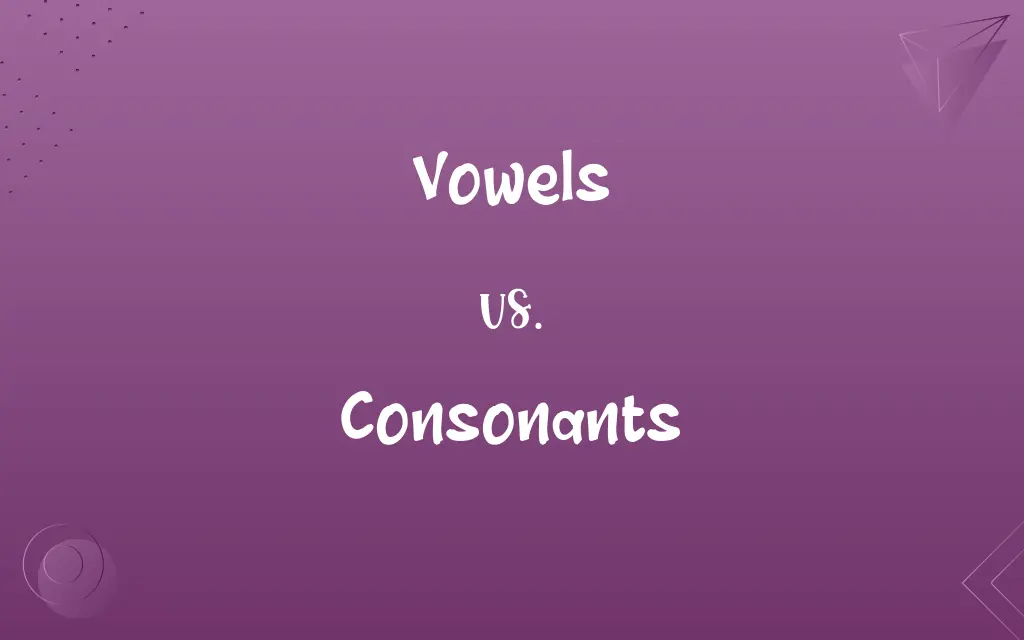Vowels vs. Consonants: Know the Difference

By Shumaila Saeed || Published on January 11, 2024
Vowels are speech sounds made without any significant constriction or blockage of air flow in the vocal tract, while consonants are made with a noticeable constriction.

Key Differences
Vowels are characterized by the open configuration of the vocal tract, allowing a smooth flow of air. In contrast, consonants involve a degree of closure or narrowing in the vocal tract, impacting the sound's quality.
Shumaila Saeed
Jan 11, 2024
Vowels form the nucleus of syllables and are essential for their formation; they can stand alone or with consonants. Consonants, however, typically require vowels to form syllables and are rarely found in isolation.
Shumaila Saeed
Jan 11, 2024
The way vowels are produced involves the shape and position of the tongue and lips, but without significant airflow restriction. Consonants, on the other hand, are produced by obstructing the vocal tract, either partially or completely.
Shumaila Saeed
Jan 11, 2024
In terms of sound, vowels are typically more sonorous and can be sustained longer. Consonants often provide the distinct edges of syllables and are shorter in duration.
Shumaila Saeed
Jan 11, 2024
Vowels are often the carriers of tone and stress in languages, whereas consonants provide the articulatory framework and distinguish between words in a language.
Shumaila Saeed
Jan 11, 2024
ADVERTISEMENT
Comparison Chart
ADVERTISEMENT
Vowels and Consonants Definitions
Vowels
Vowels vary in sound based on tongue and lip position.
Under uses the vowel 'u'.
Shumaila Saeed
Dec 15, 2023
Consonants
Consonants add distinctness to speech sounds.
Fish includes the consonants 'f' and 'sh'.
Shumaila Saeed
Dec 15, 2023
Vowels
Vowels are often the loudest part of a syllable.
Echo features the vowel 'e'.
Shumaila Saeed
Dec 15, 2023
Consonants
Consonants are speech sounds formed with some constriction in the vocal tract.
Cat starts with the consonant 'c'.
Shumaila Saeed
Dec 15, 2023
Vowels
Vowels are sounds produced without any closure in the vocal tract.
In eat, the 'e' is a vowel.
Shumaila Saeed
Dec 15, 2023
ADVERTISEMENT
Consonants
Consonants shape the edges and boundaries of syllables.
Bring ends with the consonants 'ng'.
Shumaila Saeed
Dec 15, 2023
Vowels
Vowels can be voiced and sustained without interruption.
Ice begins with the vowel 'i'.
Shumaila Saeed
Dec 15, 2023
Consonants
Consonants often require the use of the tongue, teeth, or lips.
Dog begins with the consonant 'd'.
Shumaila Saeed
Dec 15, 2023
Vowels
Vowels are central to the formation of syllables.
Apple starts with the vowel 'a'.
Shumaila Saeed
Dec 15, 2023
Consonants
Being in agreement or accord
Remarks consonant with our own beliefs.
Shumaila Saeed
Dec 13, 2023
Vowels
A speech sound, such as (ē) or (ĭ), created by the relatively free passage of breath through the larynx and oral cavity, usually forming the most prominent and central sound of a syllable.
Shumaila Saeed
Dec 13, 2023
Vowels
A letter, such as a, e, i, o, u, and sometimes y in the English alphabet, that represents a vowel.
Shumaila Saeed
Dec 13, 2023
Consonants
A speech sound produced by a partial or complete obstruction of the air stream by any of various constrictions of the speech organs, such as (p), (f), (r), (w), and (h).
Shumaila Saeed
Dec 13, 2023
Consonants
Consonants can be voiced or voiceless.
Ghost starts with the voiceless consonant 'g'.
Shumaila Saeed
Dec 15, 2023
Repeatedly Asked Queries
How are vowels produced?
Vowels are produced by shaping the vocal tract but without closing it.
Shumaila Saeed
Jan 11, 2024
What are consonants?
Consonants are sounds made with noticeable constriction in the vocal tract.
Shumaila Saeed
Jan 11, 2024
Do consonants need vowels to form syllables?
Yes, consonants typically require vowels to form syllables.
Shumaila Saeed
Jan 11, 2024
Are vowels longer than consonants?
Generally, vowels can be sustained longer than consonants.
Shumaila Saeed
Jan 11, 2024
Can vowels stand alone in speech?
Yes, vowels can form syllables on their own.
Shumaila Saeed
Jan 11, 2024
Can consonants be voiced or voiceless?
Yes, consonants can be either voiced or voiceless.
Shumaila Saeed
Jan 11, 2024
How are consonants produced?
Consonants are produced by partially or fully obstructing the vocal tract.
Shumaila Saeed
Jan 11, 2024
Do all languages have the same consonants?
No, the set of consonants varies across languages.
Shumaila Saeed
Jan 11, 2024
What are vowels?
Vowels are sounds made without any significant blockage of air flow in the vocal tract.
Shumaila Saeed
Jan 11, 2024
Can vowels be silent?
Rarely in English, but in some languages, vowels can be silent.
Shumaila Saeed
Jan 11, 2024
Can consonants form clusters in words?
Yes, consonants can cluster together without intervening vowels.
Shumaila Saeed
Jan 11, 2024
What role do vowels play in language?
Vowels often carry the tone and stress of words.
Shumaila Saeed
Jan 11, 2024
Are vowels more important than consonants in speech?
Both are equally important for clear and effective communication.
Shumaila Saeed
Jan 11, 2024
Do vowels change in pronunciation?
Yes, vowel pronunciation can change based on accent and dialect.
Shumaila Saeed
Jan 11, 2024
Can consonant pronunciation vary?
Yes, like vowels, consonants can also vary in pronunciation.
Shumaila Saeed
Jan 11, 2024
How many vowels are there in English?
English has 5 vowel letters, but the actual number of vowel sounds is greater.
Shumaila Saeed
Jan 11, 2024
What is the linguistic function of consonants?
Consonants help distinguish between different words and sounds.
Shumaila Saeed
Jan 11, 2024
How many consonants are in the English language?
English has 21 consonant letters.
Shumaila Saeed
Jan 11, 2024
Are vowel sounds the same in all languages?
No, vowel sounds vary significantly among different languages.
Shumaila Saeed
Jan 11, 2024
Share this page
Link for your blog / website
HTML
Link to share via messenger
About Author
Written by
Shumaila SaeedShumaila Saeed, an expert content creator with 6 years of experience, specializes in distilling complex topics into easily digestible comparisons, shining a light on the nuances that both inform and educate readers with clarity and accuracy.









































































